Immerse Cambodia the local way ....
The itineraries designed just for you
Experienced and dedicated local guides
Destination experts behind all journey
Go beyond to support whenever you need us
Overview
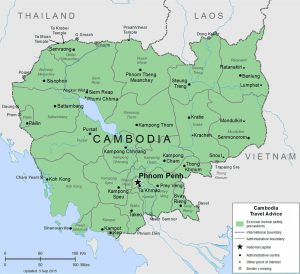 Cambodia, officially known as the Kingdom of Cambodia, is a country located in the southern portion of the Indochina Peninsula in Southeast Asia. It is 181,035 square kilometers (69,898 square miles) in area, bordered by Thailand to the northwest, Laos to the northeast, Vietnam to the east, and the Gulf of Thailand to the southwest. Cambodia has a population of over 17 million. The official religion is Theravada Buddhism, practiced by approximately 95 percent of the population. The country’s minority groups include Vietnamese, Chinese, Chams, and 30 hill tribes. The capital and largest city is Phnom Penh, the political, economic, and cultural centre of Cambodia. The kingdom is a constitutional monarchy with Norodom Sihamoni, a monarch chosen by the Royal Throne Council, as head of state. The head of government is Hun Manet, who is currently selected.
Cambodia, officially known as the Kingdom of Cambodia, is a country located in the southern portion of the Indochina Peninsula in Southeast Asia. It is 181,035 square kilometers (69,898 square miles) in area, bordered by Thailand to the northwest, Laos to the northeast, Vietnam to the east, and the Gulf of Thailand to the southwest. Cambodia has a population of over 17 million. The official religion is Theravada Buddhism, practiced by approximately 95 percent of the population. The country’s minority groups include Vietnamese, Chinese, Chams, and 30 hill tribes. The capital and largest city is Phnom Penh, the political, economic, and cultural centre of Cambodia. The kingdom is a constitutional monarchy with Norodom Sihamoni, a monarch chosen by the Royal Throne Council, as head of state. The head of government is Hun Manet, who is currently selected.
In 802 AD, Jayavarman II declared himself king, uniting the warring Khmer princes of Chenla under the name “Kambuja”. This marked the beginning of the Khmer Empire which flourished for over 600 years, allowing successive kings to control and exert influence over much of Southeast Asia and accumulate immense power and wealth. The Indianized kingdom built monumental temples including Angkor Wat, now a World Heritage Site, and facilitated the spread of first Hinduism, then Buddhism to much of Southeast Asia. After the fall of Angkor to Ayutthaya in the 15th century, a reduced and weakened Cambodia was then ruled as a vassal state by its neighbours. In 1863 Cambodia became a protectorate of France which doubled the size of the country by reclaiming the north and west from Thailand.
Cambodia gained independence in 1953. The Vietnam War extended into the country with the US bombing of Cambodia from 1969 until 1973. Following the Cambodian coup of 1970, the deposed king gave his support to his former enemies, the Khmer Rouge. The Khmer Rouge emerged as a major power, taking Phnom Penh in 1975 and later carrying out the Cambodian Genocide from 1975 until 1979, when they were ousted by Vietnam and the Vietnamese-backed People’s Republic of Kampuchea in the Cambodian–Vietnamese War (1979–91). Following the 1991 Paris Peace Accords, Cambodia was governed briefly by a United Nations mission (1992–93). The UN withdrew after holding elections in which around 90 percent of the registered voters cast ballots. The 1997 coup placed power solely in the hands of Prime Minister Hun Sen and the Cambodian People’s Party, who remain in power as of 2017.
The country faces numerous challenges. Important sociopolitical issues include widespread poverty, pervasive corruption, lack of political freedoms, low human development and a high rate of hunger. Cambodia has been described by Human Rights Watch’s Southeast Asian Director, David Roberts, as a “vaguely communist free-market state with a relatively authoritarian coalition ruling over a superficial democracy. While per capita income remains low compared to most neighbouring countries, Cambodia has one of the fastest growing economies in Asia with growth averaging 6 percent over the last decade. Agriculture remains the dominant economic sector, with strong growth in textiles, construction, garments, and tourism leading to increased foreign investment and international trade. Cambodia scored dismally in an annual index (2015) ranking the rule of law in 102 countries, placing 99th overall and the worst in the region.
Cambodia also faces environmental destruction as an imminent problem. The most severe activity in this regard is considered to be the countrywide deforestation, which also involves national parks and wildlife sanctuaries. Overall, environmental destruction in Cambodia comprises many different activities, including illegal logging, poaching of endangered and endemic species, and destruction of important wildlife habitats from large scale construction projects and agricultural businesses. The degrading activities involve the local population, Cambodian businesses and political authorities, as well as foreign criminal syndicates and many transnational corporations from all over the world.
Cambodia Weather
Rainy Season in Cambodia
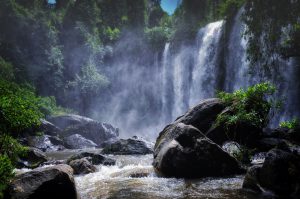 Cambodia’s wet season comes courtesy of the southwest monsoon, which blows from May to October, bringing with it some three-quarters of Cambodia’s annual rainfall. Not surprisingly, wet season is characterized by rain, and during the peak of wet season from July to September it can rain every day. Rainy days however tend to have a few hours of heavy rain rather than being all-day downpours, though the latter do sometimes occur –you will get wet travelling in a Cambodian wet season.Aside from getting drenched, the main disadvantage of travelling in wet season in Cambodia relates to flooding and degraded road conditions. The bulk of roads in Cambodia are dirt and in wet season they turn to heavily rutted and pot-holed mud pits. Travelling in rural areas, particularly the north and northeast of the country, can be slowed considerably. You will still be able to go just about anywhere, it will just take longer.
Cambodia’s wet season comes courtesy of the southwest monsoon, which blows from May to October, bringing with it some three-quarters of Cambodia’s annual rainfall. Not surprisingly, wet season is characterized by rain, and during the peak of wet season from July to September it can rain every day. Rainy days however tend to have a few hours of heavy rain rather than being all-day downpours, though the latter do sometimes occur –you will get wet travelling in a Cambodian wet season.Aside from getting drenched, the main disadvantage of travelling in wet season in Cambodia relates to flooding and degraded road conditions. The bulk of roads in Cambodia are dirt and in wet season they turn to heavily rutted and pot-holed mud pits. Travelling in rural areas, particularly the north and northeast of the country, can be slowed considerably. You will still be able to go just about anywhere, it will just take longer.
A secondary problem are bridges being out, but this is becoming less of an issue as the quality of bridgework is improving. Cambodia’s arterial routes — namely Phnom Penh to Siem Reap, Phnom Penh to Battambang and Phnom Penh to Sihanoukville — are all-weather, sealed affairs and far less of a problem than the unsealed roads.
Dry season in Cambodia
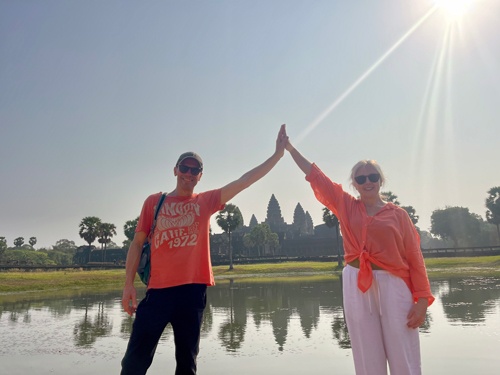 Cambodia’s dry season runs from October to April, when the dusty northeast monsoon arrives. Blowing like a hair-dryer set to high, the northeast monsoon dries out the country fast. While November and January are quite cool (high C20s) by April, the weather is scorching and oh-so- dry it will take your breath away. Characterized by heat and dust, this season coincides with Cambodia’s peak tourist season – travellers arrive in their droves between November and January to take advantage of the lack of rain and relative cool. By March, travelling can be uncomfortable and hot, while April can be excruciating.As the country dries out, badly rutted roads get graded and trip times improve dramatically, though they get incredibly dusty. Cambodia’s beach strips at Kep, Sihanoukville and Ko Kong bask in brilliant sunshine with clear calm waters — if you’re a beach bum, dry season is the season for you.
Cambodia’s dry season runs from October to April, when the dusty northeast monsoon arrives. Blowing like a hair-dryer set to high, the northeast monsoon dries out the country fast. While November and January are quite cool (high C20s) by April, the weather is scorching and oh-so- dry it will take your breath away. Characterized by heat and dust, this season coincides with Cambodia’s peak tourist season – travellers arrive in their droves between November and January to take advantage of the lack of rain and relative cool. By March, travelling can be uncomfortable and hot, while April can be excruciating.As the country dries out, badly rutted roads get graded and trip times improve dramatically, though they get incredibly dusty. Cambodia’s beach strips at Kep, Sihanoukville and Ko Kong bask in brilliant sunshine with clear calm waters — if you’re a beach bum, dry season is the season for you.
Summary Season in Cambodia
Dry season runs from November to April on the back of the northeast monsoon. The months of November to January are cooler, while February to April is hot and dusty. November is the coolest month, April the hottest.Wet season runs from May to October courtesy of the southwest monsoon. Wet season brings some three-quarters of Cambodia’s annual rainfall. July to September are the wettest months.
Cambodia Geography
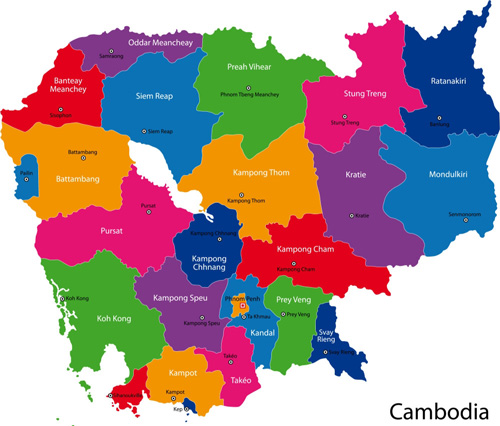 Cambodia is a country in mainland South-east Asia, bordering Thailand, Laos, Vietnam, the Gulf of Thailand and covers a total area of 181,035 km2 (69,898 sq mi). The country is situated in its entirety inside the tropical Indomalaya ecozone and the Indochina Time zone (ICT).
Cambodia is a country in mainland South-east Asia, bordering Thailand, Laos, Vietnam, the Gulf of Thailand and covers a total area of 181,035 km2 (69,898 sq mi). The country is situated in its entirety inside the tropical Indomalaya ecozone and the Indochina Time zone (ICT).
Cambodia’s main geographical features are the low-lying Central Plain that includes the Tonlé Sap basin, the lower Mekong River flood-plains and the Bassac River plain surrounded by mountain ranges to the north, east, in the south-west and south. The central lowlands extend into Vietnam to the south-east. The south and south-west of the country constitute a 443 km (275 mi) long coast at the Gulf of Thailand, characterized by sizable mangrove marshes, peninsulas, sandy beaches and headlands and bays. Cambodia’s territorial waters account for over 50 islands. The highest peak is Phnom Aural, sitting 1,810 metres (5,938 ft) above sea level.
The landmass is bisected by the Mekong River, which at 486 km (302 mi) is the longest river in Cambodia. After extensive rapids, turbulent sections and cataracts in Laos, the river enters the country at Stung Treng province, is predominantly calm and navigable during the entire year as it widens considerably in the lowlands. The Mekong’s waters disperse into the surrounding wetlands of central Cambodia and strongly affect the seasonal nature of the Tonlé Sap lake.Two third of the country’s population live in the lowlands, where the rich sediment deposited during the Mekong’s annual flooding makes the agricultural lands highly fertile. As deforestation and over-exploitation affected Cambodia only in recent decades, forests, low mountain ranges and local eco-regions still retain much of their natural potential and although still home to the largest areas of contiguous and intact forests in mainland Southeast Asia,multiple serious environmental issues persist and accumulate, which are closely related to rapid population growth, uncontrolled globalization and inconsequent administration.
The majority of the country lies within the Tropical savanna climate zone, as the coastal areas in the South and West receive noticeably more and steady rain before and during the wet season. These areas constitute the easternmost fringes of the south-west monsoon, determined to be inside the Tropical monsoon climate. Countrywide there are two seasons of relatively equal length, defined by varying precipitation as temperatures and humidity are generally high and steady throughout the entire year.
Know What To Do & What Not To Do
Most of what one should do and should not do are common sense, and are the same for visitors to any country. However, there are those customs peculiar to Southeast Asia.
The use of illegal drugs is strictly prohibited, Do not patronize prostitutes, Rude or inappropriate behavior toward local people or other members of the tour is not allowed Any member of the group exhibiting any of the behaviors described above may be ask to discussed of what should change by our ground operator.
Religion & Monks
You should not touch monks or their robes
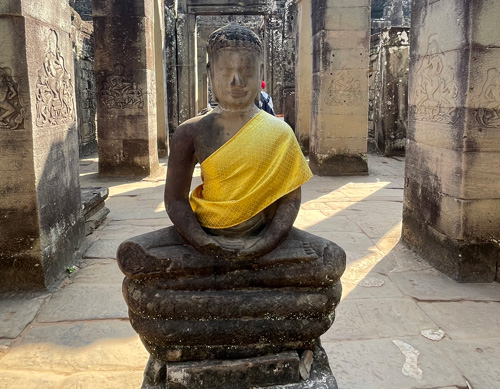 .Theravada Buddhism is the prevailing official religion in Cambodia and approximately ninety percent of the population is Buddhist. Islam, Hinduism and Christianity are also embraced in Cambodia.Since Buddha statues and images represent the revered Buddha, visitors are asked to treat all such statues and images with respect, so as not to offend local people.In Cambodia, regardless of religion, the country maintains a harmonized state.
.Theravada Buddhism is the prevailing official religion in Cambodia and approximately ninety percent of the population is Buddhist. Islam, Hinduism and Christianity are also embraced in Cambodia.Since Buddha statues and images represent the revered Buddha, visitors are asked to treat all such statues and images with respect, so as not to offend local people.In Cambodia, regardless of religion, the country maintains a harmonized state.
Be respectful when entering a temple just as you would when entering any house of worship. Religious objects such as statues of Buddha, offerings, altars, etc. may not be touched or moved. Shoes and hats must be removed before entering a temple, with the shoes being left outside Shirts must be worn inside temples, and ones shoulders should be covered. One should not sit in a temple with the feet pointed toward a Buddhist statue. It is customary to sit facing the statue with the legs folded under you.
Please do not bother monks during times of prayer. Always be respectful when taking photos of monks, especially during the morning alms procession. If a monk agrees to pose for a picture with you, please pose respectfully (ex. do not put your arm around the monk)
Angkor Wat & Archeological Sites
Even today Angkor Wat and other temple sites are regarded as places of worship, and the
following practices need to be observed:
- When visiting Angkor Wat, please wear appropriate clothing as with other temples by covering your shoulders and knees
- Shoes are appropriate footwear, but flip-flops and slippers are not. Sturdy sandals and open- toed shoes with heel straps may be worn. This is not only out of respect, but also because a lot of walking and some climbing is involved in visiting many temple sites
- Do not climb on, sit on, or lean against any Buddhist statue
- Do not eat in the temples as it is not allowed
- Be respectful of others when taking photographs, and always ask before taking photos of other tourists or local people
Dress for Success
In Southeast Asia people dress rather conservatively. Men usually wear long pants and long- sleeved shirts, and women do not usually wear low-cut or revealing clothing.
Visitors are not necessarily expected to dress like local people, but common sense and a respect
for local custom should guide you in how you dress.There are no nude beaches in Southeast Asia, and being nude or topless in public at the beach or pool is not done.
It is customary to remove one shoes when going into someone’s house. Also some guesthouses require guests to leave their shoes at the entrance. If you are ever unsure if you need to remove your shoes, ask someone, or look for other shoes left at the entrance.
Siem Reap
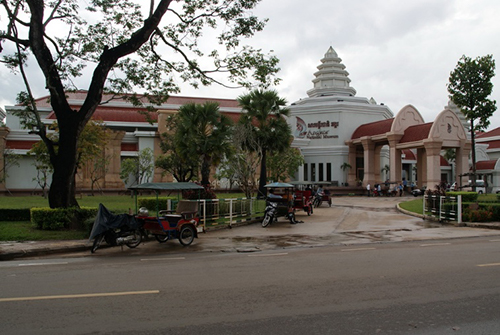
Siem Reap (Siĕm Réab [siəm riəp]) is the second-largest city of Cambodia, as well as the capital and largest city of Siem Reap Province in northwestern Cambodia.
Siem Reap possesses French-colonial and Chinese-style architecture in the Old French Quarter and around the Old Market. The city is a major hub for tourism in Cambodia due to its close proximity to the ancient temples of Angkor constructed during the Khmer Empire. In and around the city there are museums, traditional Apsara dance performances, souvenir and handicraft shops, silk farms, rice paddies in the countryside, fishing villages and a bird sanctuary near Tonlé Sap, and a cosmopolitan drinking and dining scene.
Siem Reap was named the ASEAN City of Culture for the period 2021–2022 at the 9th Meeting of the ASEAN Ministers Responsible for Culture and Arts (AMCA) organized on Oct 22, 2020.
History
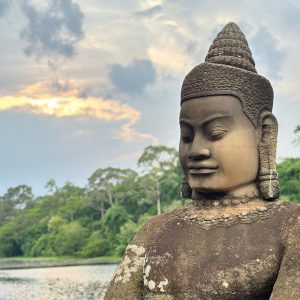
The name “Siem Reap” can be translated to mean ‘defeat of Siam’ (siem in Khmer), and is commonly taken as a reference to an incident in the centuries-old conflict between the Siamese and Khmer kingdoms, although this is probably apocryphal. According to oral tradition, King Ang Chan (1516–1566) had named the town “Siem Reap” after he repulsed an army sent to invade Cambodia by the Thai king Maha Chakkraphat in 1549. Scholars such as Michael Vickery consider this derivation to be simply a modern folk etymology, and maintain that while the names Siem Reap and Chenla, the old Chinese name for Cambodia, may perhaps be related, the actual origin of the name is unknown.
The traditional tale claims that King Ang Chan of Cambodia tried to assert greater independence from Siam, which was then struggling internally.
From the 16th to the 19th centuries, infighting among the Khmer nobility led to periodic intervention and domination by both of Cambodia’s more powerful neighbors, Vietnam and Siam. Siem Reap, along with Battambang (Phra Tabong) and Sisophon, major cities in northwest Cambodia, was under Siamese administration and the provinces were collectively known as Inner Cambodia from 1795 until 1907, when they were ceded to French Indochina.
Re-discovery of Angkor
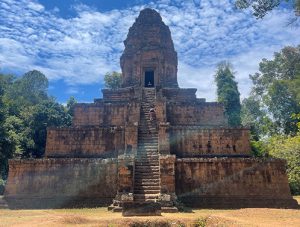
Siem Reap was little more than a village when French explorers such as Henri Mouhot “re-discovered” Angkor in the 19th century. However, European visitors had visited the temple ruins much earlier, including António da Madalena in 1586. In 1901, the École française d’Extrême-Orient (EFEO) (‘French School of the Far East’) began a long association with Angkor by funding an expedition into Siam to the Bayon.
The EFEO took responsibility for clearing and restoring the whole site. In the same year, the first Western tourists arrived in Angkor, a total of about 200 in just three months. Angkor had been “rescued” from the jungle and was assuming its place in the modern world.
With the acquisition of Angkor by the French in 1907 following a Franco-Siamese treaty, Siem Reap began to grow. The Grand Hotel d’Angkor opened in 1929 and the temples of Angkor became one of Asia’s leading draws until the late-1960s, when civil war kept tourists away. In 1975, the population of Siem Reap, like all other Cambodian cities and towns, was driven into the countryside by the communist Khmer Rouge.
Siem Reap’s recent history is colored by the horror of the Khmer Rouge regime. Since Pol Pot‘s death in 1998, however, relative stability and a rejuvenated tourist industry have revived the city and province.
Siem Reap now serves as a small gateway town to the world heritage site of Angkor Wat. In recent years, the city has regularly ranked in the top ten for “Best Destination” lists produced by entities such as TripAdvisor, Wanderlust Magazine, and Travel+Leisure.
Economy
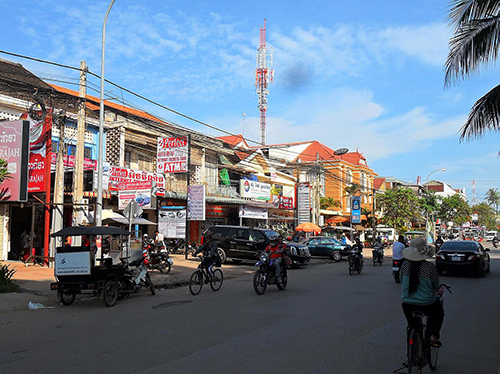
Tourism is a very important aspect of the economy of Siem Reap: it was estimated in 2010 that over 50% of jobs in the town were related to the tourism industry. The city has seen a massive increase in tourist arrivals in the decades since the end of the Khmer Rouge era, and businesses centered on tourism have flourished due to the tourism boom. Visitor numbers were negligible in the mid-1990s, but by 2004, over half a million foreign visitors had arrived in Siem Reap Province that year, approximately 50% of all foreign tourists in Cambodia. By 2018, tourist numbers had reached over 10 million.
Angkor Archaeological Park
Angkor
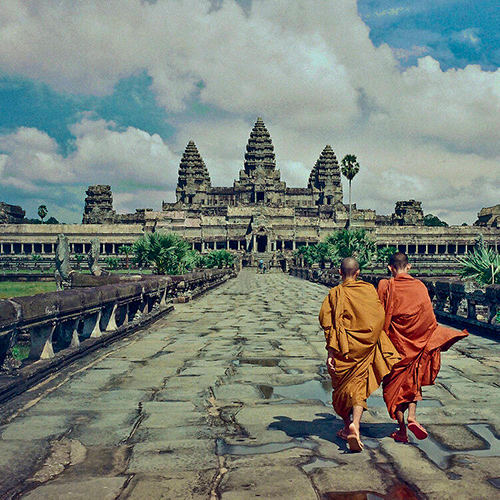
Angkor is one of the most important archaeological sites in South-East Asia. Stretching over some 400 km2, including forested area, Angkor Archaeological Park contains the magnificent remains of the different capitals of the Khmer Empire, from the 9th to the 15th century. They include the famous Temple of Angkor Wat and, at Angkor Thom, the Bayon Temple with its countless sculptural decorations. UNESCO has set up a wide-ranging programme to safeguard this symbolic site and its surroundings.
Outstanding Universal Value
Angkor, in Cambodia’s northern province of Siem Reap, is one of the most important archaeological sites of Southeast Asia. It extends over approximately 400 square kilometres and consists of scores of temples, hydraulic structures (basins, dykes, reservoirs, canals) as well as communication routes. For several centuries Angkor, was the centre of the Khmer Kingdom. With impressive monuments, several different ancient urban plans and large water reservoirs, the site is a unique concentration of features testifying to an exceptional civilization. Temples such as Angkor Wat, the Bayon, Preah Khan and Ta Prohm, exemplars of Khmer architecture, are closely linked to their geographical context as well as being imbued with symbolic significance. The architecture and layout of the successive capitals bear witness to a high level of social order and ranking within the Khmer Empire. Angkor is therefore a major site exemplifying cultural, religious and symbolic values, as well as containing high architectural, archaeological and artistic significance.
The park is inhabited, and many villages, some of whom the ancestors are dating back to the Angkor period are scattered throughout the park. The population practices agriculture and more specifically rice cultivation.
Criteria
The Angkor complex represents the entire range of Khmer art from the 9th to the 14th centuries, and includes a number of indisputable artistic masterpieces (e.g. Angkor Wat, the Bayon, Banteay Srei).
The influence of Khmer art as developed at Angkor was a profound one over much of South-east Asia and played a fundamental role in its distinctive evolution.
The Khmer Empire of the 9th-14th centuries encompassed much of South-east Asia and played a formative role in the political and cultural development of the region. All that remains of that civilization is its rich heritage of cult structures in brick and stone.
Khmer architecture evolved largely from that of the Indian sub-continent, from which it soon became clearly distinct as it developed its own special characteristics, some independently evolved and others acquired from neighboring cultural traditions. The result was a new artistic horizon in oriental art and architecture.
Criteria
The Angkor complex encompasses all major architectural buildings and hydrological engineering systems from the Khmer period and most of these “barays” and canals still exist today. All the individual aspects illustrate the intactness of the site very much reflecting the splendor of the cities that once were. The site integrity however, is put under dual pressures:
- endogenous: exerted by more than 100,000 inhabitants distributed over 112 historic settlements scattered over the site, who constantly try to expand their dwelling areas;
- exogenous: related to the proximity of the town of Siem Reap, the seat of the province and a tourism hub.
Authenticity
Previous conservation and restoration work at Angkor between 1907 and 1992, especially by the École Française d’Extrême-Orient (EFEO), the Archaeological Survey of India, the Polish conservation body PKZ, and the World Monuments Fund have had no significant impact on the overall authenticity of the monuments that make up the Angkor complex and do not obtrude upon the overall impression gained from individual monuments.
Protection and management requirements
The property is legally protected by the Royal Decree on the Zoning of the Region of Siem Reap/Angkor adopted on 28 May 1994 and the Law on the protection of the natural and cultural heritage promulgated on 25 January 1996, the Royal Decree on the creation of the APSARA National Authority (Authority for the protection of the site and the management of the Angkor Region) adopted on 19 February 1995, the No. 70 SSR government Decision, dated 16 September 2004 providing for land‐use in the Angkor Park: “All lands located in zone 1 and 2 of the Angkor site are State properties”, and the sub-decree No. 50 ANK/BK on the organization and functioning of the APSARA National Authority adopted on 9 May 2008, specifically provided for the establishment of a Department of Land‐use and Habitat Management in the Angkor Park.
Flag
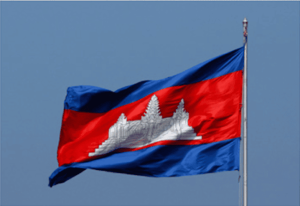 The flag of Cambodia symbolizes the country’s slogan: Nation, Religion, King. The two large blue stripes represent royalty and the center red stripe represents the nation. The image of the white temple stands for the nation’s religion.
The flag of Cambodia symbolizes the country’s slogan: Nation, Religion, King. The two large blue stripes represent royalty and the center red stripe represents the nation. The image of the white temple stands for the nation’s religion.
Food
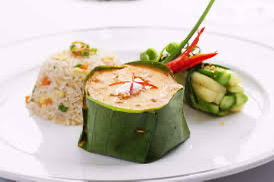 Cambodian cuisine includes noodles, soups, grills, stir-fried, curries, salads, desserts, lots of vegetables, tropical fruits, and of course rice which is the staple food for Cambodians. Cambodian culinary secrets are rarely written down; the recipes were instead handed down from mother to daughter. From an ancient origin has come a traditional cuisine of unsuspected treasures: a unique blend of flavors and colors that enhance the natural ingredients used.Cambodians perfected the art of blending spice paste using many ingredients like cloves, cinnamon, star anise, nutmeg, cardamom, ginger and turmeric. They add other native ingredients like galangal, garlic, shallots, lemongrass, cilantro, and kaffir lime leaves to these spices to make a rather distinctive and complex spice blend known as “kroeung”.
Cambodian cuisine includes noodles, soups, grills, stir-fried, curries, salads, desserts, lots of vegetables, tropical fruits, and of course rice which is the staple food for Cambodians. Cambodian culinary secrets are rarely written down; the recipes were instead handed down from mother to daughter. From an ancient origin has come a traditional cuisine of unsuspected treasures: a unique blend of flavors and colors that enhance the natural ingredients used.Cambodians perfected the art of blending spice paste using many ingredients like cloves, cinnamon, star anise, nutmeg, cardamom, ginger and turmeric. They add other native ingredients like galangal, garlic, shallots, lemongrass, cilantro, and kaffir lime leaves to these spices to make a rather distinctive and complex spice blend known as “kroeung”.
Although noodles are also popular, almost every meal includes a bowl of rice. A wide range of curries, soups and stir fried are usually served with rice. Being in a country that produces many rice varieties, tourists can enjoy the best aromatic grains and various types of glutinous rice. The latter is more commonly served with a salad or in desserts with fruits.There are two other unique ingredients that give Cambodian cuisines their fabulous typical flavour. One is a pungent fermented fish paste known as pra-hok and the other, the kapi, a fermented prawn paste. These require an acquired taste for most but they are beloved by some who used them in many dishes or even taken as a dipping sauce. Collectively, these ingredients have become an important aromatic combination commonly used in Cambodian cuisines.Typically, a Cambodian meal is served with rice and at least three other dishes. It usually includes a soup (samlor), served alongside the main dishes. Each of the individual dishes will either be sweet, sour, salty or bitter; these exist side by side in harmony, sometimes even within a single dish, to offer an original melody. Chili is usually left up to the individual to add. In this way tourists are subtly ensured that they get a bit of every flavour to satisfy their palates.
Cambodia Visa
Visas are required for most nationalities. Your passport must be valid for at least six months beyond the end of your visit and have a whole blank page for the visa sticker. Thirty (30) day visas are available upon arrival at all main border crossings and airports. The official visa fee is US$30 for a Tourist Visa and US$35 for a Business Visa. The visa application form and one passport photo are required. Vaccination certificates are NOT required. You can apply tourist visas on-line at the below details:
Cambodia e-Visa or Electronic Visa has been introduced by Ministry of Foreign Affairs and International Cooperation in April 2006 to promote the Cambodia tourism industry. The website http://evisa.mfaic.gov.kh now serves as a platform for tourists to apply Cambodia tourist Visa online.
Why e-Visa
With e-Visa, you do not have to visit the Cambodia Embassy to apply your Visa. No submission of documents is required during the application process because e-Visa process from application to approval is completely done via the online platform. The process is very straightforward whereby the applicants just need to fill up their details and submit the payment thru the secure payment gateway with their credit card.
Is e-Visa legitimate?
Yes, e-Visa is a project launched by the Cambodian Government and fully supported by MOFA. The following countries have authenticated the legitimacy of the e-Visa service:
Over 55,000 e-Visa applications have been approved and you can read about the applicant’s experiences here.
Growth
With the help from more than 150 e-Visa friends, the e-Visa platform now supports up to 25 languages worldwide. Number of e-Visa lanes in major checkpoints also increased from the initial 5 lanes to 20 lanes as of to date. Due to the overwhelming positive responses from travelers worldwide, the number of e-Visa applicants is steadily increasing, with more than 55,000 applicants processed to date.
Phnom Penh
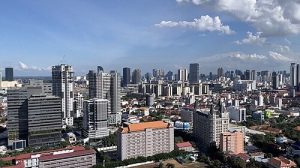 Phnom Penh is the capital and most populous city of Cambodia. It has been the national capital since 1865 and has grown to become the nation’s primate city and its political, economic, industrial, and cultural centre. The city’s name derives from Wat Phnom, a Buddhist temple, and Lady Penh, the city’s founder. It sits at the confluence of the Tonlé Sap and Mekong rivers, and is the start of the Bassac River. It is also the seat of Cambodia’s monarchy, based at the Royal Palace.
Phnom Penh is the capital and most populous city of Cambodia. It has been the national capital since 1865 and has grown to become the nation’s primate city and its political, economic, industrial, and cultural centre. The city’s name derives from Wat Phnom, a Buddhist temple, and Lady Penh, the city’s founder. It sits at the confluence of the Tonlé Sap and Mekong rivers, and is the start of the Bassac River. It is also the seat of Cambodia’s monarchy, based at the Royal Palace.
Founded in 1372, Phnom Penh succeeded Angkor Thom as the national capital in 1434 following the fall of Angkor, and remained so until 1497. It regained its capital status during the French colonial era. It underwent a period of investment and modernization during Cambodia’s independence period, earning the nickname the “Pearl of Asia” for its colonial French, New Khmer and Art Deco architecture. The city’s population swelled in the 1960s and 1970s as refugees fled from civil war and American bombing during the Vietnam War. Phnom Penh’s entire population was forcibly evacuated in 1975 by the Khmer Rouge, and faced persecution, forced labour and genocide. Phnom Penh remained largely uninhabited during the Democratic Kampuchea era until Vietnam-backed forces took the city in 1979. The city was reconstructed and infrastructure improved in the modern era with the support of international investment and aid. By 2019, it was home to more than 2 million people, approximately 14% of the Cambodian population.
History
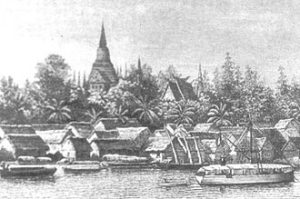
The initial settlement of Phnom Penh is believed to have been established since the 5th century AD, according to the discovery of ancient kiln site in Choeung Ek commune of Dangkao district, southern part of central Phnom Penh in the early 2000s. Choeung Ek archaeological site was one of the largest kiln pottery center in Cambodia and the earliest known kiln sites in Southeast Asia to produce the ceremonial vessels known as kendi from 5th to 13th century. Archaeologists stated that a large community is surrounded by a circular earthwork structure that is 740 metres in diameter and 4 metres high, built in the 11th century. In addition, there are remnants of other ancient village infrastructure, irrigation system, inscription, Shiva linga as well as an ancient brick temple foundation and its ornate remains which dated back to Funan era.
First recorded a century after it is said to have taken place, the legend of the founding of Phnom Penh tells of a local woman, Penh (commonly referred to as Daun Penh (Lady Penh in Khmer), living at Chaktomuk, the future Phnom Penh. It was the late 14th century, and the Khmer capital was still at Angkor near Siem Reap 350 km (217 mi) to the north. Gathering firewood along the banks of the river, Lady Penh spied a floating koki tree in the river and fished it from the water. Inside the tree she found four Buddha statues and one of Vishnu.
The discovery was taken as a divine blessing, and to some a sign that the Khmer capital was to be brought to Phnom Penh from Angkor. To house the new-found sacred objects, Penh raised a small hill on the west bank of the Tonle Sap River and crowned it with a shrine, now known as Wat Phnom at the north end of central Phnom Penh. “Phnom” is Khmer for “hill” and Penh’s hill took on the name of the founder, and the area around it became known after the hill.
Phnom Penh first became the capital of Cambodia after Ponhea Yat, king of the Khmer Empire, moved the capital from Angkor Thom after it was captured and destroyed by Siam a few years earlier. There is a stupa behind Wat Phnom that houses the remains of Ponhea Yat and the royal family as well as the remaining Buddhist statues from the Angkorean era. In the 17th century, Japanese immigrants also settled on the outskirts of present-day Phnom Penh. A small Portuguese community survived in Phnom Penh until the 17th century, undertaking commercial and religious activity in the country.
Phnom Penh remained the royal capital for 73 years, from 1432 to 1505. It was abandoned for 360 years (from 1505 to 1865) by subsequent kings due to internal fighting between the royal pretenders. Later kings moved the capital several times and established their royal capitals at various locations in Tuol Basan (Srey Santhor), Pursat, Longvek, Lavear Em and Oudong.
It was not until 1866, under the reign of King Norodom I (1860–1904), the eldest son of King Ang Duong, who ruled on behalf of Siam, that Phnom Penh became the permanent seat of government and capital of Cambodia, and the current Royal Palace was built. Beginning in 1870, the French colonial authorities turned a riverside village into a city where they built hotels, schools, prisons, barracks, banks, public works offices, telegraph offices, law courts, and health services buildings. In 1872, the first glimpse of a modern city took shape when King Norodom employed the services of French contractor Le Faucheur to construct 300 brick houses for sale and rental to Chinese traders.
By the 1920s, Phnom Penh was known as the “Pearl of Asia”, and over the next four decades, Phnom Penh continued to experience rapid growth with the building of railways to Sihanoukville and Pochentong International Airport (now Phnom Penh International Airport). Phnom Penh’s infrastructure saw major modernisation under the rule of Norodom Sihanouk
